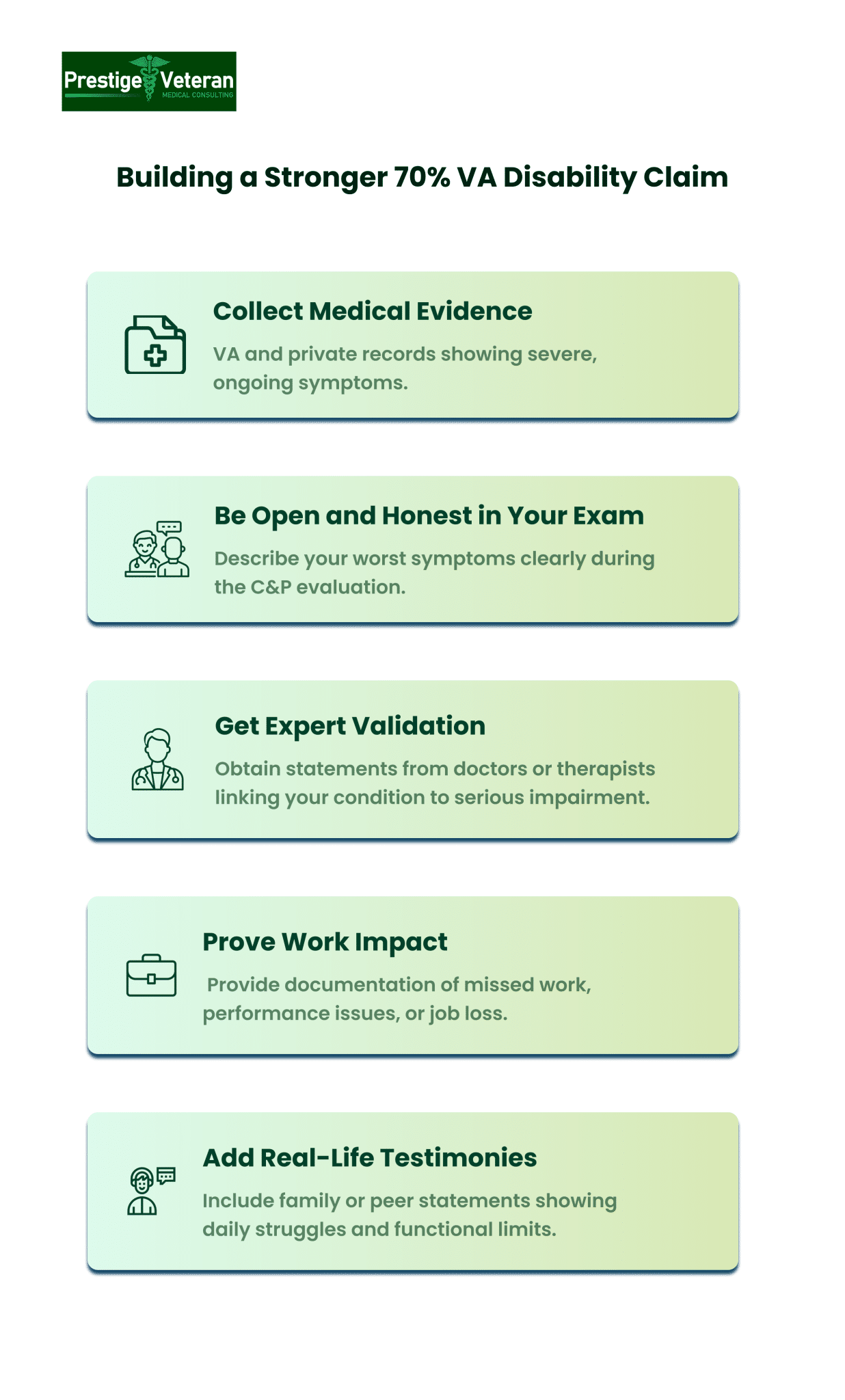A 70% disability rating represents a significant acknowledgment by the Department of Veterans Affairs (VA) that service-connected conditions seriously affect daily life and the ability to work. Yet, many veterans are unsure what this rating truly means, how it’s calculated, or what opportunities it opens for additional support.
This guide breaks down the essentials of a 70% VA disability rating, including what it represents, how it is determined, the types of conditions that often qualify, and the compensation and benefits available at this level. Whether you’re newly rated or seeking an increase, knowing how the VA evaluates disabilities can help you make informed decisions about your next steps.
Table of Contents
How the VA Rates Disabilities
The VA uses the Schedule for Rating Disabilities (VASRD) found in Title 38 of the Code of Federal Regulations (CFR), Part 4 to assign disability ratings from 0% to 100% in ten increments based on the severity of a veteran’s condition and its impact on their overall health and earning capacity.
A 0% rating indicates a condition is service-connected but not severe enough to warrant compensation. Ratings from 10% onward trigger monthly disability payments, with increasing amounts at higher percentages.
What a 70% VA Disability Rating Means
A 70% VA disability rating represents a significant acknowledgment by the Department of Veterans Affairs that a veteran’s service-connected conditions seriously affect their ability to work, maintain relationships, and manage daily life.
At the 70% level, the VA recognizes that your service-connected disabilities cause serious and persistent impairment in both occupational and social functioning, but are not entirely incapacitating. Veterans at this level often experience multiple combined conditions, such as post-traumatic stress disorder (PTSD), chronic pain, neurological disorders, or orthopedic injuries that lead to frequent flare-ups and daily impairment.
Severity and Level of Impairment
A 70% VA rating signals that service-connected conditions cause major impairment or limitation in nearly all areas of functioning. This level is considered “high,” reflecting more than moderate disability but less than total impairment.
Typical impairments at 70% VA disability might include:
- Marked limitations in adaptation to stress or work
- Frequent episodes of symptom exacerbation
- Severe functional impairment in daily life (e.g., mobility, concentration, sleep)
- Use of assistive devices, significant pain, or need for intermittent aid
Daily Limitations and Life Impact
Veterans rated at 70% may struggle with:
- Employment challenges: difficulty maintaining steady or full-time work due to physical or mental health barriers
- Cognitive strain: memory problems, poor concentration, or slowed thinking
- Physical limitations: chronic pain, reduced mobility, or restricted motion
- Mental health instability: mood swings, anxiety, sleep disturbances, or emotional outbursts
- Need for ongoing care: regular therapy, medication, or workplace accommodations
Because of such limitations, veterans with 70% disability ratings often require accommodations, therapy, and consistent follow-up.
However, it also means you are not totally disabled, as that designation is reserved for veterans rated at 100% or those who qualify for Total Disability Individual Unemployability (TDIU).
How Multiple Conditions Combine to Reach a 70% Rating
Many veterans who have more than one service-connected condition receive a 70% VA disability rating through a combined rating rather than a single condition rating. Instead of simply adding percentages together, the VA uses what’s known as “VA math,” outlined in 38 CFR §4.25 (Combined Ratings Table).
For example, if a veteran has a 50% rating and another 30% rating:
- Start with the highest rating: 50% disabled → 50% efficiency remains.
- Apply the next rating to the remaining efficiency: 30% of 50% = 15%.
- Add that 15% to the original 50%: 50% + 15% = 65% combined.
- Round to the nearest 10%: 65% → 70% total rating.
This calculation method, guided by the “Whole Person Theory,” reflects the idea that a veteran’s combined disability rating cannot exceed 100%, because the VA evaluates how multiple disabilities affect the veteran as a whole person rather than adding each percentage directly.
This approach ensures a fairer representation of overall impairment, especially when multiple service-connected disabilities (e.g., PTSD, musculoskeletal injuries, hearing loss) interact and compound one another. Understanding how VA math works is crucial, as it can significantly affect total compensation and eligibility for benefits such as TDIU or Special Monthly Compensation (SMC).
Disabilities That Frequently Qualify for 70% VA Rating
Certain disabilities are more commonly rated at 70% due to the severity of symptoms and functional restrictions they cause. Below are several examples of conditions often receiving a 70% VA rating, along with how the VA evaluates each.
Post-Traumatic Stress Disorder (PTSD)
A 70% rating for PTSD reflects severe, persistent symptoms such as panic attacks, suicidal thoughts, or emotional instability. Veterans at this level experience major occupational and social impairment, often struggling to maintain relationships or consistent employment.
Major Depressive Disorder and Other Mental Health Conditions
Conditions such as major depressive disorder, generalized anxiety disorder, bipolar disorder, OCD, and panic disorder often receive a 70% rating when they result in hopelessness, suicidal ideation, or a marked inability to function independently. Veterans at this level often experience significant disruption in work, family life, and social interactions.
Traumatic Brain Injury (TBI)
A 70% VA disability rating for TBI is typically assigned when cognitive and emotional impairments like memory loss, poor focus, headaches, and mood swings severely limit independence. Such TBI symptoms greatly affect judgment, social interaction, and consistent occupational functioning.
Chronic Pain and Orthopedic Conditions
Severe spinal, knee, joint, or nerve-related disorders may qualify for a 70% rating when pain is constant, motion is restricted, and function is heavily reduced. These conditions often limit mobility, independence, and the ability to perform daily activities.
Severe Migraines
Migraines are typically rated at 70 percent when the VA confirms frequent, prostrating attacks that require bed rest or medical attention. Veterans at this level often report debilitating pain, nausea, and light sensitivity that severely impact work reliability and daily functioning.
Neurological Disorders
The VA may assign a 70% rating for neurological disorders such as peripheral neuropathy, multiple sclerosis, or Parkinson’s disease when symptoms include motor loss, tremors, or significant coordination problems.
Respiratory Disorders
A 70% VA disability rating is often granted when respiratory diseases like severe asthma, COPD, or sleep apnea linked with secondary depression, anxiety, or heart complications that cause serious breathing limitations, frequent treatment, or oxygen dependence. These conditions result in chronic fatigue, poor concentration, and major occupational impairment.
Endocrine and Gastrointestinal Disorders
Serious diabetes, thyroid disorders, Crohn’s disease, Irritable Bowel Syndrome (IBS), or ulcerative colitis can qualify for a 70% rating when they produce systemic effects like weight loss, chronic fatigue, or frequent hospitalization. These symptoms substantially interfere with health, stamina, and work performance.
These conditions often meet the 70% threshold because the VA recognizes how profoundly they limit independence, stability, and overall quality of life for affected veterans.
VA Disability Pay Chart: Monthly Compensation for a 70% Rating
Once you’re awarded a 70% VA disability rating, the next question arises: How much compensation will I receive each month?
VA disability compensation is a tax-free monthly payment meant to offset the loss of earning capacity due to service-connected conditions. These payments are made at the beginning of each month for the previous month. The amount depends on:
- Your disability rating (in this case, 70%),
- Your dependency status (spouse, children, dependent parents), and
- Annual Cost-of-Living Adjustments (COLA) set by the federal government.
For 2025, the VA applied a 2.5% Cost-of-Living Adjustment (COLA), following Social Security’s annual adjustment. For example, a veteran with a 70% disability rating and no dependents saw their monthly benefit increase from $1,716.28 to $1,759.19, reflecting the 2.5% raise.
Below are the estimated monthly VA compensation rates for 2025 for veterans with a 70% disability rating:
| Veteran’s Status | 2025 Monthly Payment (Estimated) |
| Veteran alone | $1,759.19 |
| Veteran with spouse | $1,908.19 |
| Veteran with spouse and one child | $2,028.19 |
| Veteran with one parent (no spouse/children) | $1,879.19 |
| Veteran with two parents | $1,999.19 |
| Additional child under 18 | +$70.00 each |
| Additional child over 18 in school | +$234.00 each |
Source: VA.gov — Current disability compensation rates (2025)
Tip: When COLA increases are announced, the VA automatically adjusts your monthly payment. Always check the official VA disability pay chart for current amounts.
VA Back Pay
If the VA takes time to process a claim or upgrade, a veteran may be entitled to back pay, retroactive payments from the effective date of the decision to the date the VA actually disburses funds. The back pay includes all missed months’ compensation.
For many veterans, a 70% VA disability rating offers a strong foundation of financial stability. For those unable to maintain steady employment due to service-connected conditions, it can also open the door to Total Disability based on Individual Unemployability (TDIU), which provides compensation at the 100% rate.
Additional Benefits at 70 Percent VA Disability
Beyond monthly VA disability compensation, a 70% disabled veteran can receive a wide range of benefits that support veteran health, housing, education, and financial well-being.
Here is a breakdown of the most important ones.
- VA Health Care (Priority Group 1) – Full access to VA medical services, hospital care, and prescriptions with no copayments.
- Vocational Rehabilitation and Employment (VR&E / Chapter 31) – Job training, education, and employment placement assistance.
- VA Home Loan Guaranty – Eligibility for VA-backed home loans with no funding fee and favorable lending terms.
- Special Monthly Compensation (SMC) – Additional pay for specific severe disabilities like loss of use of limbs or organs.
- Specially Adapted Housing (SAH) or Special Housing Adaptation (SHA) Grants – Funds to modify or purchase accessible housing.
- Travel Reimbursement for VA Medical Appointments – Compensation for mileage and expenses to attend approved appointments.
- 10-Point Veteran Preference in Federal Hiring – Competitive advantage for disabled veterans securing federal employment.
- Concurrent Retirement and Disability Pay (CRDP) – Eligible to receive both VA compensation and full military retirement pay.
- VA Life Insurance (VGLI) – Up to $500,000 in renewable life insurance coverage after service separation.
- Education Benefits (Post-9/11 GI Bill and VR&E) – Tuition, housing, and book stipends for further education or retraining.
- Property Tax Exemptions – State-level property tax reductions or exemptions for 70 percent disabled veterans.
- Commissary and Exchange Access – In-person and online shopping privileges on military bases.
- Free Tax Preparation Assistance – Access to VA-partnered or IRS volunteer tax preparation services.
- Burial and Plot Allowance – Monetary assistance for funeral and burial costs.
At a 70% VA rating, apart from a higher monthly compensation, you access a full package of benefits that may transform your support network and quality of life.
Can You Work with a 70% VA Disability Rating?
Veterans assigned a 70% VA disability rating are legally allowed to work. A 70% rating indicates significant impairment but does not automatically prevent employment. Many veterans continue part-time roles, sheltered work, or adjusted employment. However, a 70% rating assumes significant functional impairment, meaning work may be limited by factors such as:
- Mental health instability, cognitive lapses, or fatigue
- Physical pain, mobility limitations, or need for assistive devices
- Frequent medical appointments or flare-ups
- Difficulty with deadlines, stress, or a predictable schedule
For instance, a veteran managing severe back pain or musculoskeletal injuries may struggle with prolonged standing, lifting, or sitting. Thus, many veterans with a 70% rating may need flexible, accommodating employment or accommodations.
Still, those who find themselves unable to maintain substantially gainful employment due to their disabilities should explore whether they qualify for TDIU (Total Disability based on Individual Unemployability).
TDIU: 100% Compensation without 100% Rating
Total Disability based on Individual Unemployability (TDIU) pays veterans at the 100% disability compensation rate, even if their combined disability rating is less than 100%. To qualify, veterans must prove that their service-connected disabilities prevent them from holding substantially gainful employment — meaning full-time work that provides income above the federal poverty threshold. This is often a more practical route than pushing multiple conditions to reach a schedular 100%.
TDIU Eligibility Criteria
There are two main ways to qualify:
1. Schedular TDIU
You may qualify if you meet one of these conditions:
- One service-connected disability rated 60% or higher, or
- A combined rating of 70% or more, with at least one disability rated at 40% or higher (commonly known as the “70/40 rule”).
2. Extraschedular TDIU
Even if you don’t meet the above percentages, the VA may still approve TDIU under exceptional circumstances where your service-connected disabilities clearly prevent gainful employment.
If granted, TDIU gives the veteran the same monthly compensation as a 100% rating, that is, approximately $3,831.30 per month in 2025 (along with the benefits tied to 100%). Always confirm the latest figure on VA’s official rates page.
To apply, veterans must submit VA Form 21-8940 and evidence supporting their inability to work, such as employment history or doctor statements. Essentially, TDIU bridges the gap by offering 100% pay for unemployability even when the official rating remains at 70%.
70% Rating vs. TDIU Eligibility: Which is More Favorable?
- A 70% rating offers solid benefits and compensation.
- But if your conditions make employment impossible, attempting TDIU can elevate your compensation to a 100% level without needing a 100% schedular rating.
- Many veterans already rated at 70% are ideal candidates for TDIU because they meet the “70/40 rule” threshold.
- In practice, applying for TDIU may be more productive than trying to micro-increase multiple conditions.
In addition, veterans rated 100% or granted TDIU may also qualify for CHAMPVA health coverage for dependents, Dependents Educational Assistance (Chapter 35), VA dental care, and other benefits.
| Category | 70% VA Disability Rating | TDIU (Total Disability Based on Individual Unemployability) |
| Definition | Severe impairment from service-connected disabilities, but not total unemployability. | Granted when service-connected conditions make substantially gainful employment impossible. |
| Compensation Rate (2025) | About $1,759.19/month for a single veteran. | About $3,831.30/month, equal to a 100% schedular rating. |
| Work Eligibility | Can work full-time or part-time (no income limit). | Limited to marginal employment — typically earning below the federal poverty level. |
| Eligibility Criteria | Combined 70% rating from service-connected disabilities. | One disability at 60%+, or combined 70%+ with one at 40%+. |
| Primary Focus | Severity of symptoms and impairment level. | Impact of disabilities on the ability to work and earn income. |
| Healthcare Benefits | Priority Group 1 — full VA healthcare, no copays. | Same as 100% rating — full VA healthcare, dependents’ and ancillary benefits. |
| Outcome | Recognizes severe impairment but permits employment. | Provides full 100% pay and benefits for veterans unable to work. |
Evidence to Prove Your 70% VA Disability
Securing a 70% VA rating requires presenting evidence showing how your symptoms directly result in severe occupational and social impairment. Let’s say you are filing for 70% VA disability for Post-Traumatic Stress Disorder (PTSD). In that case, you will need the following documentation to prove your claim.

1. Strengthen Your Claim with Medical Records
Provide detailed VA and private psychiatric evaluations confirming your PTSD diagnosis and describing major symptoms like panic attacks, flashbacks, or suicidal thoughts. Treatment notes showing limited progress despite consistent therapy strengthen your case for a 70% VA disability rating.
2. Be Transparent During the C&P Examination
Clearly describe your worst PTSD symptoms, like daily anxiety, emotional outbursts, and inability to maintain focus or relationships during the VA C&P exam. For instance, you might say, “Most days I’m barely holding it together. My anxiety, anger, and sleep problems make it hard to be around people or keep a steady job.”
3. Support Your Case with Professional Opinions
Secure written statements from the treating psychiatrist or therapist explaining how PTSD limits your ability to handle stress, interact socially, or maintain employment. Ask them to reference DSM-5 criteria and link those criteria to your functional limitations.
4. Demonstrate Work-Related Impairment
Submit employment records, attendance logs, or supervisor statements verifying:
- Work absences
- Performance decline, or
- Termination due to panic episodes or anger outbursts
These documents help prove occupational impairment and strengthen your claim for a 70 percent VA disability.
5. Add Credibility with Lay and Family Testimonies
Include detailed statements from your spouse, family, or fellow veterans describing noticeable changes like withdrawal, aggression, nightmares, or poor hygiene and how PTSD limits your everyday functioning.
Establishing Service Connection
To qualify for any VA disability rating, including 70 percent, you must demonstrate that your PTSD is service-connected. This requires three essential elements:
- A current diagnosis of PTSD from a qualified professional.
- An in-service stressor or traumatic event, such as combat exposure, sexual assault, or another service-related trauma.
- A nexus, or medical link, demonstrating that your PTSD is “at least as likely as not” caused by your military service.
A detailed nexus letter from a mental health professional can be powerful evidence in establishing this connection and demonstrating the severity of functional impairments in line with the VA rating criteria.
How to Increase Your 70% VA Disability Rating
Suppose you’re currently rated at 70% by the VA and believe your service-connected conditions have worsened or that your initial rating doesn’t reflect the full impact on your daily life. In that case, there are several ways to seek an increase from a 70% rating to 80%, 90%, or achieve a 100% pay through Total Disability Individual Unemployability (TDIU).
1. Request a Re-Evaluation if Symptoms Worsen
The VA increases disability ratings based on symptom severity and how your condition limits your ability to work and function. Hence, if your symptoms have significantly worsened since your last Compensation & Pension (C&P) exam, you can request a re-evaluation.
Be prepared to describe in detail how your conditions now impact your work, relationships, and daily life. Veterans frequently underreport symptoms during exams, which leads to underrating. A well-documented re-evaluation can move you from a 70 percent VA disability to a higher tier of benefits.
2. File a Claim for an Increased Rating with Solid Medical Evidence
If your service-connected condition has deteriorated since your last evaluation, you can file a claim for an increased rating (VA Form 21-526EZ).
- Gather updated medical records, new diagnostic test results (imaging, labs, etc.), or statements from your doctor showing the progression of your disability.
- Ask your private provider to complete a Disability Benefits Questionnaire (DBQ) that thoroughly documents your current symptoms, functional limitations, and impact on overall life.
- Even better, request a nexus letter that states that your condition is “at least as likely as not” caused or aggravated by your service.
These records show the VA how your symptoms line up with their rating criteria and make your request for a higher percentage harder to deny.
3. Obtain Independent Medical Opinions or Nexus Letters
One of the most impactful ways to strengthen your case for elevating a 70% VA disability rating is through a detailed, independent medical nexus letter. This letter should link your current condition to your military service, outline how it has worsened, and reference the VA rating criteria. Former C&P examiners and board-certified specialists, e.g. a neurologist or psychiatrist familiar with VA disability benefits by percentage, can provide valuable, regulation-based opinions to support your case.
For example, a veteran originally rated 70% for a severe knee injury began experiencing chronic hip arthritis (30%) and lower back pain (20%) from years of uneven weight-bearing and limited mobility. After submitting orthopedic evaluations and a detailed nexus letter linking these secondary conditions to the primary service-related knee damage, the VA increased the veteran’s overall rating to 90%.
4. Add Secondary Service-Connected Conditions
Many veterans develop new conditions linked to existing service-connected disabilities, and that’s an opportunity to boost their combined percentage. For instance, a veteran with a 70% PTSD rating who develops secondary migraines or hypertension can file additional claims to reach an 80% or 90% combined rating. Each approved disability adds to your combined disability rating, moving you closer to 100% through what’s often called “VA math.”
5. Apply for Total Disability Based on Individual Unemployability (TDIU)
If your service-connected conditions prevent you from holding a steady job, TDIU might pay you at the 100% rate even if your rating stays at 70%. To qualify under the VA 70/40 rule, you must have at least one disability rated 40% or higher and a total combined rating of 70% or more. TDIU is a great option for veterans who can’t work full-time because of pain, PTSD, or other severe limitations.
Tip: Statements from former employers, Social Security Disability (SSDI) findings, or vocational expert assessments can support a TDIU claim.
6. Use Lay Statements to Back Up Your Claim
The VA values “competent lay evidence” under 38 CFR §3.159, which means personal observations from family members, coworkers, or service buddies who witness your daily limitations can carry significant weight when combined with medical findings. For example, a spouse might explain your struggles with anger, sleep, or pain management; an employer might confirm that you missed work due to medical appointments or symptoms.
The VA considers both clinical and functional impairment when adjusting ratings, so credible lay or buddy statements paired with medical evidence can tip the scales toward an increase.
7. Appeal a Low or Incorrect VA Decision
If you believe the VA underrated your condition, you can appeal within one year of your decision letter. There are three appeal paths:
- Supplemental Claim: Submit new evidence (medical records, nexus letters, or witness statements).
- Higher-Level Review: Request a senior VA reviewer to reexamine your case for potential errors.
- Board Appeal: Present your case to a Veterans Law Judge for final review.
Successful appeals not only adjust your rating but may entitle you to back pay from the date you originally filed for an increase. Many veterans gain higher ratings through this process, especially with representation from a VA-accredited attorney who understands how to match your evidence to VA rating criteria.
How to File a Claim for a 70 Percent VA Disability Rating
To file a claim for a 70% VA disability rating, you must have a current, diagnosed condition caused or aggravated by military service that severely limits daily life or work. Once you have confirmed your eligibility, take these steps:
Step 1: Gather Evidence. Collect service treatment records, VA and private medical records, lay or buddy statements describing daily impact, and a personal statement explaining your symptoms and how they affect functioning.
Step 2: File Your Claim.
- The fastest way to submit your disability claim is online at VA.gov/disability/how-to-file-claim using VA Form 21-526EZ.
- You can also mail the form to the VA Evidence Intake Center (P.O. Box 4444, Janesville, WI 53547-4444) or
- Submit the claim in person at a regional VA office.
- Track your claim through VA.gov → Check your claim or appeal status.
Step 3: Attend the C&P Exam. After filing, the VA may schedule a Compensation & Pension exam to assess your condition’s severity. Be honest and detailed about all symptoms and their effects, as VA raters consider this exam report when assigning ratings.
Step 4: Receive Decision and Rating. The VA reviews all evidence and issues a decision letter explaining your percentage rating (0-100%) and compensation. A 70% rating provides tax-free monthly payments and access to enhanced VA benefits.
Step 5: If You Disagree. Many veterans believe they should have received a higher rating. If you’re dissatisfied with the VA decision, you can request a Higher-Level Review, submit a Supplemental Claim with new evidence, or appeal to the Board of Veterans’ Appeals within one year.
For free assistance, work with a VA-accredited Veterans Service Officer (VSO). Consider applying for TDIU if your service-connected conditions prevent full-time work.
Final Thoughts
A 70% VA disability rating recognizes the serious impact your service-connected conditions have on your daily life and future. While it offers substantial benefits and financial support, it’s also a point from which many veterans can pursue higher compensation or TDIU if working becomes too difficult. Continue documenting your symptoms, seek professional guidance, and use the resources available through the VA and VSOs. Advocacy, awareness, and persistence can ensure you receive the full recognition and support you’ve earned.
Disclaimer: This article provides general information, not legal or benefits advice. Policies change. Verify details on VA.gov or with a qualified Veterans Service Officer (VSO) before making decisions or claims.
Frequently Asked Questions (FAQ)
What does a 70% VA disability get?
A 70% VA disability rating recognizes service-connected impairments that severely limit work and daily functioning, and is eligible for monthly tax-free compensation and full VA healthcare benefits.
How much is 70 percent VA disability in 2025?
In 2025, a single veteran with a 70% VA disability rating receives about $1,759.19 per month, with higher amounts for dependents.
Is 70% PTSD a permanent VA disability?
A 70% PTSD rating is not automatically permanent, but can become permanent if the VA determines the condition is unlikely to improve with treatment.
How hard is it to go from 80% to 100% VA disability?
It’s challenging to go from 80% to 100% because of VA’s “combined ratings math,” but veterans unable to work may qualify for TDIU, which pays at the 100% rate.
How much is 70 VA disability with a spouse?
A veteran rated at 70% with a spouse receives about $1,857.28 per month in 2025.
What is a 70 VA rating for mental health?
A 70% mental health rating, such as for PTSD or depression, reflects severe, persistent symptoms causing major occupational and social impairment.
How to get 70 percent VA disability for depression?
To get 70% for depression, you must show medical evidence and documentation that your service-connected depression severely limits daily life, relationships, and work performance.
What benefits do you get with a 70% VA disability rating?
Veterans rated at 70% receive benefits including tax-free disability compensation, priority VA healthcare (often with no copays), education support, home loan advantages, vocational programs, life insurance, property tax exemptions (state-dependent), and more.
Can a veteran with a 70% VA disability work?
Yes. Many veterans with a 70% rating continue to work in adapted roles or part-time. However, if your conditions make gainful employment impossible, applying for TDIU may qualify you for the full 100% rate.
What is the difference between a 70% VA rating and TDIU?
A 70% rating is schedular and reflects severity. TDIU, if approved, pays at the 100% rate even without reaching 100% schedular, but requires proof that you cannot maintain substantially gainful employment.
Also read: VA 5, 10, and 20-Year Rules: Protect Your Disability Rating
At Prestige Veteran Medical Consulting, a veteran-owned company, we specialize in Independent Medical Opinions (IMOs) known as Nexus letters.
Our purpose is to empower YOU, the veteran, to take charge of your medical evidence and provide you with valuable educational tools and research to guide you on your journey.
Understanding the unique challenges veterans face, our commitment lies in delivering exceptional service and support.
Leveraging an extensive network of licensed independent medical professionals, all well-versed in the medical professional aspects of the VA claims process, we review the necessary medical evidence to incorporate in our reports related to your VA Disability Claim.
Prestige Veteran Medical Consulting is not a law firm, accredited claims agent, or affiliated with the Veterans Administration or Veterans Services Organizations. However, we are happy to discuss your case with your accredited VA legal professional.













